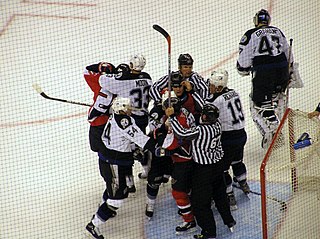 W
WViolence has been a part of ice hockey since at least the early 1900s. According to the book Hockey: A People's History, in 1904 alone, four players were killed during hockey games from the frequent brawls and violent stickwork.
 W
WA bench-clearing brawl is a form of ritualistic fighting that occurs in sports, most notably baseball and ice hockey, in which every player on both teams leaves their dugouts, bullpens, or benches, and charges the playing area in order to fight one another or try to break up a fight. Penalties for leaving the bench can range from nothing to severe.
 W
WFighting in ice hockey is an established tradition of the sport in North America, with a long history that involves many levels of amateur and professional play and includes some notable individual fights. Fighting may be performed by enforcers, or "goons" —players whose role is to fight and intimidate—on a given team, and is governed by a system of unwritten rules that players, coaches, officials, and the media refer to as "the code". Some fights are spontaneous, while others are premeditated by the participants. While officials tolerate fighting during hockey games, they impose a variety of penalties on players who engage in fights.
 W
WHigh-sticking is the name of two infractions in the sport of ice hockey that may occur when a player intentionally or inadvertently plays the puck with his or her stick above the height of the shoulders or above the cross bar of a hockey goal. This can result in a penalty or a stoppage of play. In the rules of the National Hockey League, high-sticking is defined as a penalty in Rule 60 and as a non-penalty foul in Rule 80.A penalty is assessed if a player strikes another player with a high stick. The player is given a minor penalty unless his high stick caused an injury, in which case the referee has the option to assess a double-minor, major, game misconduct or match penalty. It is the referee's discretion which penalty to assess: the rule calls for a double minor for an accidental injury, or a match penalty for a deliberate attempt to injure. Injury is usually decided by the high stick causing bleeding, but the presence of blood does not automatically mean an extra penalty is awarded. Some referees have been known to award an extra penalty without the presence of blood if the referee determines that the injury sustained was sufficient to warrant a double-minor penalty. A stoppage in play results if a high stick comes in contact with the puck and the team who touched it regains control of the puck. However, play usually continues if a player touches the puck with a high stick and the opposing team gains control of the puck. If the puck goes into the opposing net after coming into contact with a high stick, the goal is disallowed. The level at which a stick is considered too high for a goal is the crossbar of the net. However, if a player knocks the puck into his own net with a high stick, the goal is allowed.
 W
WA Gordie Howe hat trick is a variation on ice hockey's hat-trick. It is accomplished when a player collects a goal, an assist, and a fight in the same game. It is named after Hall of Famer Gordie Howe.
 W
WThe Punch-up in Piestany was a bench-clearing brawl between Canada and the Soviet Union, during the final game of the 1987 World Junior Ice Hockey Championships in Piešťany, Czechoslovakia, on January 4, 1987. The incident resulted in the ejection of both nations, and while the Soviets had already been eliminated from medal contention, the disqualification cost Canada a medal – potentially the gold. The brawl is famous for officials having turned off the arena lights in a desperate attempt at ending the 20-minute melee. Much of the blame was placed on Norwegian referee Hans Rønning, who had been selected for the game based on his perceived neutrality rather than experience.
 W
WThe Richard Riot was a riot on March 17, 1955, in Montreal, Quebec, Canada. The riot was named after Maurice Richard, the star ice hockey player for the Montreal Canadiens of the National Hockey League (NHL). Following a violent altercation on March 13 in which Richard hit a linesman, NHL president Clarence Campbell suspended him for the remainder of the 1954–55 NHL season, including the playoffs. Montreal fans protested that the suspension was too severe; the team's largely Francophone fan base claimed the length of the suspension was motivated by Richard's French Canadian ethnicity. Outside of Montreal, however, the suspension was seen as justified and, if anything, too short.